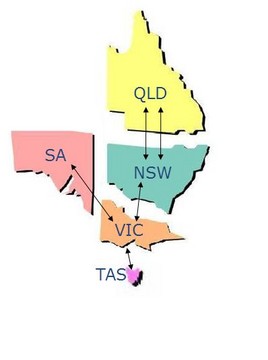Intro to the Australian Electricity Physical Market
The Australian National Electricity Market (NEM) physical (i.e. spot) market
The National Electricity Market (NEM) is an interconnected grid comprising several connected regional networks and approximately 45,900 MW of installed generation. The NEM spot pool market is operated by AEMO and operates across the eastern states of the mainland, and includes the state grids of (QLD), New South Wales (NSW), Victoria (VIC) and South Australia (SA). Tasmania (TAS) is connected to the other NEM regions via an undersea inter-connector to Victoria. Futures and options contracts are listed on the 4 major regions (VIC, SA, QLD and NSW).

AEMO publishes a half-hourly spot pool price for electricity in each region based on a gross pool merit order dispatch system. All retailers and market customers purchase their power from the spot pool market in their relevant region and pay the spot market price to AEMO (i.e. the spot price determines the retailer's supply cost). All generators that supply power to the regional pool market during this time receive the spot market price from AEMO (i.e. the spot price determines the generator's revenue). Free realtime spot market data is available from www.aemo.com.au. A more detailed overview of the Australian physical and financial electricity market, is provided by the Australian Energy Regulator's annual "State of the Energy Market Report" available from www.aer.gov.au . The spot pool price varies from $-1,000/MWh to +$16,600/MWh, so retailers and generators hedge this floating price risk by locking in a fixed power price rate by buying or selling derivative contracts (contracts for differences).
The spot price (and the price of futures contracts used to "lock in" long term revenues or costs at a fixed rate) provide the market signals for investment in new generation and competitive responses from new entrant retail suppliers. This market-driven investment signaling benefits energy consumers in the long term. i.e. high spot prices and futures prices (e.g. if the power supply/demand balance is tight) signal new generation investment seeking higher revenues thereby ensuring the security of power supply. Conversely, low spot prices and futures prices signal new retailer competitors and energy intensive industry to enter the relevant regional market to take advantage of lower power supply costs.
The Electricity Futures and Options Market
It is against the published pool price that all derivative products, such as futures are (cash) settled on contract expiry. Base load futures are cash settled with reference to the average of every half hour of the relevant quarter, while peak load futures are cash settled with reference to the average of only those half hours during the quarter between 7am to 10pm on working weekdays.
The Australian market is one of the few purely cash settled electricity markets (i.e. financial contracts do not involve physical delivery of electricity) which enables participants such as banks to participate in the financial market and contribute to market liquidity without a requirement to own physical generation assets.
Electricity futures contracts are listed on a calendar quarter basis out to 4 years ahead and also trade in 1 year tranches via defined Calendar Year and Financial Year Strip Products. Products traded include exchange traded swap futures (also $300 cap futures) and options on swap futures, providing the facility for credit-clean option position taking.
A large volume of OTC negotiated business is brought to the ASX for clearing and registration by brokers and/or trading clients via the ASX Block Trading mechanism. Additionally, the exchange-for-physical (EFP) mechanism enables OTC hedge contracts to be switched into futures via registration on the ASX Clear (Futures), to eliminate OTC credit default risk.
Recommended Reading
1. The Australian Energy Regulator, "State of the Market Report" available at www.aer.gov.au provides an excellent overview of Australian energy markets including the National Electricity spot market and electricity derivatives markets.
2. The Australian Energy Market Operator, provides extensive spot market data and other information at www.aemo.com.au
3. The Australian Financial Markets Association, "Australian Financial Markets Report" provides useful liquidity statistics on centrally cleared ASX electricity derivatives and bilateral OTC electricity derivatives. www.afma.com.au